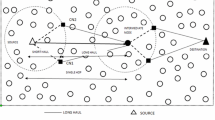Abstract
Differential unitary space time modulation (USTM) is identified as one of the best non-coherent technique for future 5th generation mobile networks. Two or more nodes with single antennas cooperate with each other to form a cooperative multiple-input–multiple-output network. In, this paper we examine the use of differential cooperative USTM that avoids channel estimation and also prolong the lifetime of wireless sensor network. Aiming at minimizing the energy consumption per bit we form a differential cooperative energy minimization algorithm by optimally selecting the number of cooperative nodes and finding the route that consumes minimum energy.






Similar content being viewed by others
References
Akyildiz, I. F., Su, W., Sankarasubramaniam, Y., & Cayirci, E. (2002). Wireless sensor networks: A survey. Computer Networks, 38(4), 393–422.
Proakis, J. G. (2000). Digital communications (4th ed.). New York: McGraw-Hill.
Cui, S., Andrea, J. Goldsmith., & Ahmad B. (2003). Modulation optimization under energy constraints. In Proceedings of ICC’03, AK (pp. 2805–2811).
Cui, S., Goldsmith, A. J., & Ahmad, B. (2004). Energy efficiency of MIMO and co-operative MIMO techniques in sensor networks. IEEE Journal on Selected Areas in Communications, 22(6), 1089–1098.
Jayaweera, S. K. (2006). Virtual MIMO based cooperative communication for energy constrained wireless sensor networks. IEEE Transactions on Wireless Communications, 5(5), 984–989.
Zuo, Y., Gao, Q., & Fei, L. (2010). Energy optimization of wireless sensor through co-operative MIMO with data aggregation. In Proceedings of 21st annual IEEE international symposium on personal, indoor and mobile radio communications (pp. 1602–1607).
Bian, Y., Cheng, M., Wen, L., Yang, H., Poor, V., & Jiao, B. (2015). Differential spatial modulation. IEEE Transactions on Vehicular Technology, 64(7), 3262–3268.
Hanzo, L., Akhtman, J., Wang, L., & Jiang, M. (2010). MIMO-OFDM for LTE, WiFi and WiMax: Coherent versus non-coherent and cooperative turbo-transceivers.. New York: Wiley.
Hochwald, B. M., & Sweldens, W. (2000). Differential unitary space–time modulation. IEEE Transactions on Communications, 48(12), 2041–2052.
Nguyen, D. N., & Krunz, M. A. (2014). Cooperative MIMO framework for wireless sensor networks. ACM Transactions on Sensor Networks, 10(3), 1–30.
Jun, L., Miaowen, W., Xiang, C., Moon, H. L., Sangseob, S., & Yier, Y. (2016). Differential spatial modulation with gray coded antenna activation order. IEEE Communications Letters, 20(6), 1100–1103.
Lei, A., & Schober, R. (2004). Multiple-symbol differential decision fusion for mobile sensor network. IEEE Transaction on Wireless Communication, 9(2), 778–790.
Liu, L., Wang, Z, & Zhou, M. C. (2008). Cooperative multipath routing and relay based on non-coherent detection in wireless sensor networks. In Conference on automation science and engineering (pp. 128–132).
Chung, J. M., Kim, J., & Han, D. (2012). Multihop hybrid virtual MIMO scheme for wireless sensor networks. IEEE Transactions on Vehicular Technology, 61(9), 4069–4078.
Zhang, D., & Chen, Z. (2013). Energy efficiency of cooperative communication with guaranteed E2E reliability in WSNs. International Journal of Distributed Sensor Networks, 9(4), 1–11.
Yetgin, H., Chenng, K. T. K., El-Hajjar, M., & Hanzo, L. (2014). Cross-layer network lifetime optimization considering transmit and signal processing power in wireless sensor networks. IET Wireless Sensor Systems, 4(4), 176–182.
Faouk, F., Rizki, R., Fayez, W., & Zaki, F. (2014). Multi-level stable and energy-efficient clustering protocol in heterogeneous wireless sensor networks. IET Wireless Sensor Systems, 4(4), 159–169.
Schurgers, C., Aberthorne, O., Srivastava, M. B. (2001). Modulation scaling for energy aware communication systems. In Proceedings of the international symposium on low power electronics and design (pp. 96–99).
Himsooz, T., Siriwongpairat, P., Han, Z., & Ray Liu, K. J. (2007). Lifetime maximization via cooperative nodes and relay deployment in wireless networks. IEEE Journal on Selected Areas in Communications, 25(2), 306–317.
Senthil Kumar, K., & Amutha, R. (2016). An algorithm for energy efficient cooperative communication in wireless sensor networks. KSII Transactions on Internet and Information Systems, 10(7), 3080–3099.
Zhang, J., Fei, F., Gao, Q., & Xiao-Hong, P. (2011). Energy-efficient multihop cooperative MISO transmission with optimal hop distance in wireless ad hoc networks. IEEE Transactions on Wireless Communications, 10(10), 3426–3435.
Senthil Kumar, K., & Amutha, R. (2015). Energy efficient cooperative communication in wireless sensor networks using turbo codes. Australian Journal of Electrical and Electronics Engineering, 12(4), 293–300.
Senthil Kumar, K., Amutha, R., & Snehapiriya, T. L. K. (2017). Energy efficient V-MIMO using turbo codes in wireless sensor networks. In IEEE international conference on computing and communication technology (pp. 293–298).
Senthil Kumar, K., & Amutha, R. (2016). Delay efficiency analysis of turbo coded cooperative communication in wireless sensor networks. Australian Journal of Basic and Applied Sciences, 10(1), 451–456.
Senthil Kumar, K., Amutha, R., & Priyanga, R. (2017). MPSK modulation based energy efficient wireless body area network. International Journal of Advanced Research Trends in Engineering and Technology, 4(19), 272–276.
Kanthimathi, M., & Amutha, R. (2017). Performance analysis of generalized differential modulation using DAPSK for bi-directional relay networks. In IEEE international conference on computing and communication technology (pp. 33–36).
Goldsmith, A. (2015). Wireless communications (2nd ed., p. 2015). Cambridge: Cambridge University Press.
Author information
Authors and Affiliations
Corresponding author
Additional information
Publisher's Note
Springer Nature remains neutral with regard to jurisdictional claims in published maps and institutional affiliations.
Rights and permissions
About this article
Cite this article
Kanthimathi, M., Amutha, R. & Senthil Kumar, K. Energy Efficient Differential Cooperative MIMO Algorithm for Wireless Sensor Networks. Wireless Pers Commun 103, 2715–2728 (2018). https://doi.org/10.1007/s11277-018-5957-1
Published:
Issue Date:
DOI: https://doi.org/10.1007/s11277-018-5957-1




